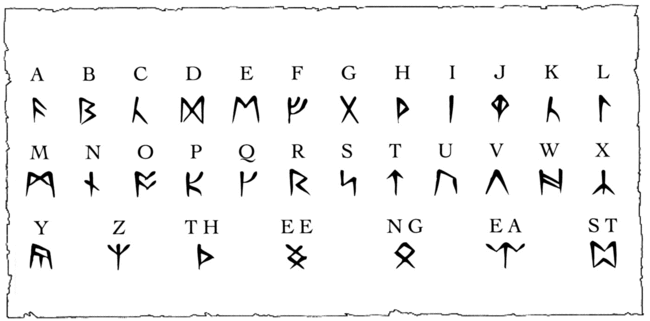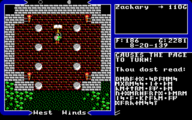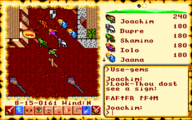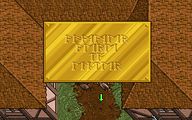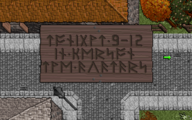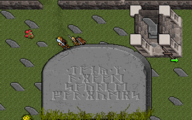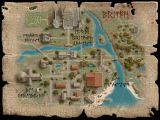Runic alphabet
This article is about an alphabet used throughout the Ultima series. For other uses, see Runes (disambiguation).
Since the first entry in the series, the Ultima games made use of the runic alphabet on its maps and in game manuals (see especially The Book of Mystic Wisdom from Ultima IV).
History[edit]
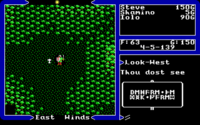
The runic alphabet is based on the Germanic/Norse runic alphabet. Throughout the ages, the alphabet has taken on new letters and experienced subtle changes to the shape of the existing ones. Most notably, the original alphabet had no equivalent to 'Q' and 'V' shared the same letter as 'U'. Additionally, the runic alphabet sports several special characters that represent very common two-letter combinations.
After first being encountered on maps, it was in Ultima IV where runic first became critically important, as the shrines only relayed the true Axiom of Infinity in runic. Beginning with Ultima V, this alphabet was also frequently seen on signs, in books, etc. For example, the Words of Power were only revealed in runic and one important message from the Codex of Ultimate Wisdom had to be manually translated. Also, the Book of Lore mentioned that by that time runic was already more common in the countryside than in cities.
The runic alphabet, after being very common in Ultima V and Ultima VI, slowly began to wane in the time of Ultima VII. In The Book of Fellowship Batlin claimed that it was slowly being replaced by the Latin alphabet. While the replacement was clearly not complete in Britannia, by the time of the Avatar's arrival, the Fellowship was never seen using the runic alphabet and Batlin was dismissive of it, calling it "an antiquated style of operation".
The Translation spell found on Serpent Isle did translate both these runes and the ancient Ophidian writings. Runic's use was common on Serpent Isle in the settlements of the new colonists, but not in the ruins of the Ophidians, who had developed their own alphabet.
By Ultima IX, the runic alphabet could only be seen on the town maps and it was stated that its usage has been reduced significantly. Nevertheless, all official documents were still written in runic, as noted in the Journal.
Lore[edit]
| “ | The language of Britannia is rich and poetic. It is derived from Old Sosarian, which varies mostly from the widespread current language in its alphabet, which is more runic than today’s. The old runes continue to be used widely in rural areas, and there is a movement to increase their familiarity to city people. Still, among the cityborn, translation of runic messages, letter for letter, is sometimes necessary. The Runic Alphabet is the earliest known system of writing sounds using runes or letters. The most commonly used runes follow, with their modem equivalents. – from The Book of Lore (Ultima V)
|
|---|
| “ | In your travels you will no doubt come upon the occasional sign or placard written in a curious runic script. Passed down from one generation to the next, this written runic language is directly descended from the language of the druids of old. Though strange and seemingly indecipherable, the process of interpreting runic script is really quite simple. The following key will enable the traveler to translate runic characters into his native tongue. – from Compendium (Ultima VI)
|
|---|
| “ | Following a tradition that has been passed down from generation to generation for centuries, many signs and placards in Britannia are written in a unique and attractive runic script that was once the language of the druids. This strange writing is older than Britannia itself. While the presence of such writing might befuddle a casual tourist, the wise traveller knows that it is a worthwhile pursuit to learn the meaning of this writing. Nowadays, the use of rune writing is beginning to fall out of fashion, and its use generally denotes an establishment that clings to an antiquated style of operation. – from The Book of Fellowship (Ultima VII)
|
|---|
| “ | I include an alphabet of the druidic runes as well. I do this for comparison’s sake only, for I can but hope that any similarities between our language, the druidic runes and the serpentine alphabet will lead to a better understanding of their ancient culture. |
|---|
| “ | The use of runic script has waned in recent years, yet one cannot journey through Britannia without encountering the ancient alphabet in maps, scrolls or signs of various kinds. It is part of our rich heritage. As such, it should not be forgotten. |
|---|
Trivia[edit]
- The alphabet has been in use since the Ultima I maps of Sosaria. Since no guide was provided at this time, manual translation is required, after determining the names of the features that are printed on the map.
- Runic magic in Ultima Underworld and Ultima Underworld II got its name from the use of runic letters etched onto the stones that are used for casting, each letter representing one Word of Power, with the exception of xen and zu missing. See: rune stones
- Even though runic has been used since Ultima I, Ultima IV was the first game to be shipped with a translation guide.
- Runic was also known to the Zealans of Pagan, as Bentic describes it as “archaic alphabet”. How they acquired it is not explained.
- Translating runic in Ultima IV is necessary to solve the final puzzle of the game. This also applies to Ultima V, as the Words of Power are only given in runic.
- Runic is also found in the spellbooks in Ultima VII and Ultima VII Part Two. Spell scrolls found on the Serpent Isle, however, use the Ophidian alphabet.
- Runic was at first used on Ultima Online maps, but the obscure alphabet was abandoned in later installments.
- The rune cypher found on the reference card of Shroud of the Avatar is for some reason missing the special characters that represent very common two-letter combinations. Also of note is that several letters exchanged runes or got completely new ones, causing difficulties for veterans to read runic.
Gallery[edit]
The runic Codex message in Ultima V
Reading a runic sign in Ultima VI
A sign in runic from Ultima VII
Runic on a town map in Ultima IX
Runic alphabet in Ultima IV (note the missing letters Q and V)
The rune cypher on the reference card of Shroud of the Avatar
See also[edit]
External Links[edit]
- Game Font Database – Ultima – Several fonts from different Ultima alphabets
- Runic Font Converter – an on-line tool for converting Latin text to several known runic fonts. Also a mirror for runic fonts.
